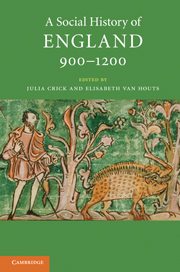Book contents
- Frontmatter
- Contents
- List of figures
- List of maps and tables
- List of contributors
- Acknowledgements
- List of abbreviations
- Map 1 England and its neighbours
- Map 2 England 900–1200
- I Introduction
- I.1 Land use and people
- I.2 Water and land
- I.3 Forest and upland
- I.4 Mineral resources
- I.5 Health and disease
- II.1 Authority and community
- II.2 Lordship and labour
- II.3 Order and justice
- II.4 War and violence
- II.5 Family, marriage, kinship
- II.6 Poor and powerless
- III.1 Towns and their hinterlands
- III.2 Commerce and markets
- III.3 Urban planning
- III.4 Urban populations and associations
- IV.1 Invasion and migration
- IV.2 Ethnicity and acculturation
- IV.3 Intermarriage
- IV.4 The Jews
- V.1 Religion and belief
- V.2 Rites of passage and pastoral care
- V.3 Saints and cults
- V.4 Public spectacle
- V.5 Textual communities (Latin)
- V.6 Textual communities (vernacular)
- VI.1 Learning and training
- VI.2 Information and its retrieval
- VI.3 Esoteric knowledge
- VI.4 Medical practice and theory
- VI.5 Subversion
- Glossary
- Time line 900–1200
- Further reading
- Index
V.1 - Religion and belief
Published online by Cambridge University Press: 05 June 2012
- Frontmatter
- Contents
- List of figures
- List of maps and tables
- List of contributors
- Acknowledgements
- List of abbreviations
- Map 1 England and its neighbours
- Map 2 England 900–1200
- I Introduction
- I.1 Land use and people
- I.2 Water and land
- I.3 Forest and upland
- I.4 Mineral resources
- I.5 Health and disease
- II.1 Authority and community
- II.2 Lordship and labour
- II.3 Order and justice
- II.4 War and violence
- II.5 Family, marriage, kinship
- II.6 Poor and powerless
- III.1 Towns and their hinterlands
- III.2 Commerce and markets
- III.3 Urban planning
- III.4 Urban populations and associations
- IV.1 Invasion and migration
- IV.2 Ethnicity and acculturation
- IV.3 Intermarriage
- IV.4 The Jews
- V.1 Religion and belief
- V.2 Rites of passage and pastoral care
- V.3 Saints and cults
- V.4 Public spectacle
- V.5 Textual communities (Latin)
- V.6 Textual communities (vernacular)
- VI.1 Learning and training
- VI.2 Information and its retrieval
- VI.3 Esoteric knowledge
- VI.4 Medical practice and theory
- VI.5 Subversion
- Glossary
- Time line 900–1200
- Further reading
- Index
Summary
By the year 900 England had already been shaped for three centuries or more by a Christian message which had spread from the north and west with Irish missionaries and from the south with the mission that arrived in 597 with Augustine of Canterbury (d. 604). That message was a meaning- rich account of existence in which a God-created world was riven by suffering and death because of the disobedience of the first human beings. That ‘Fall’, and the original sin which henceforth stained all born into the world, had been restored when God entered the world as Christ, a God-man who suffered and died to redeem the sins of humankind and then rose from the dead to seal his promise of eternal life. Through him, the Church taught, and through the remedies, the sacraments, which the Church offered in his name, salvation was possible for the believer. Moreover all, believer and unbeliever alike, would face Christ eventually for he would return at the end of days to judge the quick and dead, delivering the righteous into heaven and the wicked into the eternal fire. These essential messages ran like a golden thread through the conversion, into our period and beyond, but their institutional setting and detailed elaboration were subject to enormous change during the central Middle Ages. The Church itself was subject to a transformation which had major ramifications for the regions. Papal power, in particular, increased exponentially.
- Type
- Chapter
- Information
- A Social History of England, 900–1200 , pp. 265 - 289Publisher: Cambridge University PressPrint publication year: 2011



